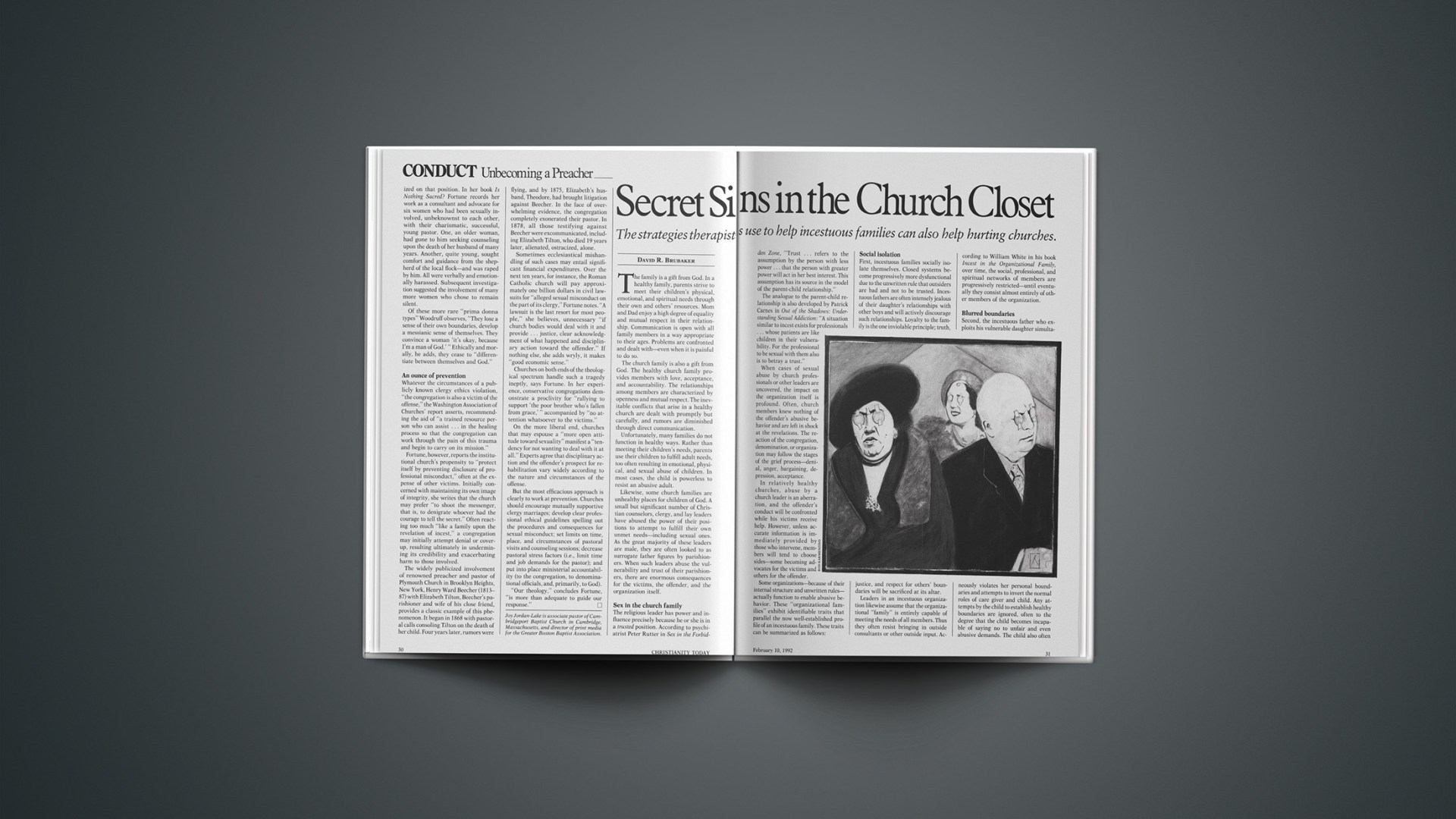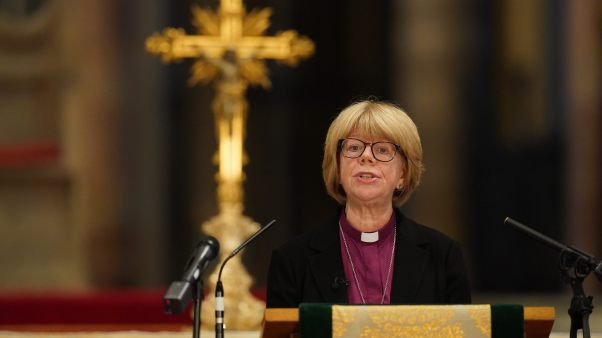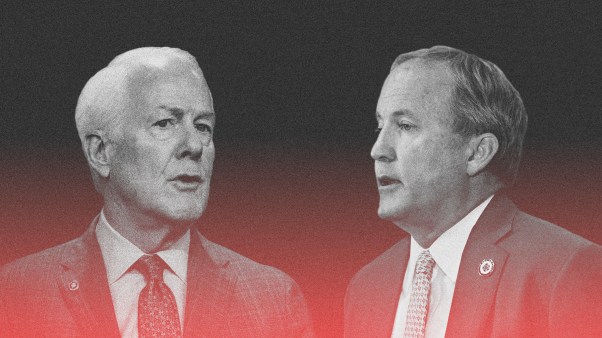The family is a gift from God. In a healthy family, parents strive to meet their children’s physical, emotional, and spiritual needs through their own and others’ resources. Mom and Dad enjoy a high degree of equality and mutual respect in their relationship. Communication is open with all family members in a way appropriate to their ages. Problems are confronted and dealt with—even when it is painful to do so.
The church family is also a gift from God. The healthy church family provides members with love, acceptance, and accountability. The relationships among members are characterized by openness and mutual respect. The inevitable conflicts that arise in a healthy church are dealt with promptly but carefully, and rumors are diminished through direct communication.
Unfortunately, many families do not function in healthy ways. Rather than meeting their children’s needs, parents use their children to fulfill adult needs, too often resulting in emotional, physical, and sexual abuse of children. In most cases, the child is powerless to resist an abusive adult.
Likewise, some church families are unhealthy places for children of God. A small but significant number of Christian counselors, clergy, and lay leaders have abused the power of their positions to attempt to fulfill their own unmet needs—including sexual ones. As the great majority of these leaders are male, they are often looked to as surrogate father figures by parishioners. When such leaders abuse the vulnerability and trust of their parishioners, there are enormous consequences for the victims, the offender, and the organization itself.
Sex In The Church Family
The religious leader has power and influence precisely because he or she is in a trusted position. According to psychiatrist Peter Rutter in Sex in the Forbidden Zone, “Trust … refers to the assumption by the person with less power … that the person with greater power will act in her best interest. This assumption has its source in the model of the parent-child relationship.”
The analogue to the parent-child relationship is also developed by Patrick Carnes in Out of the Shadows: Understanding Sexual Addiction: “A situation similar to incest exists for professionals … whose patients are like children in their vulnerability. For the professional to be sexual with them also is to betray a trust.”
When cases of sexual abuse by church professionals or other leaders are uncovered, the impact on the organization itself is profound. Often, church members knew nothing of the offender’s abusive behavior and are left in shock at the revelations. The reaction of the congregation, denomination, or organization may follow the stages of the grief process—denial, anger, bargaining, depression, acceptance.
In relatively healthy churches, abuse by a church leader is an aberration, and the offender’s conduct will be confronted while his victims receive help. However, unless accurate information is immediately provided by those who intervene, members will tend to choose sides—some becoming advocates for the victims and others for the offender.
Some organizations—because of their internal structure and unwritten rules—actually function to enable abusive behavior. These “organizational families” exhibit identifiable traits that parallel the now well-established profile of an incestuous family. These traits can be summarized as follows:
Social Isolation
First, incestuous families socially isolate themselves. Closed systems become progressively more dysfunctional due to the unwritten rule that outsiders are bad and not to be trusted. Incestuous fathers are often intensely jealous of their daughter’s relationships with other boys and will actively discourage such relationships. Loyalty to the family is the one inviolable principle; truth, justice, and respect for others’ boundaries will be sacrificed at its altar.
Leaders in an incestuous organization likewise assume that the organizational “family” is entirely capable of meeting the needs of all members. Thus they often resist bringing in outside consultants or other outside input. According to William White in his book Incest in the Organizational Family, over time, the social, professional, and spiritual networks of members are progressively restricted—until eventually they consist almost entirely of other members of the organization.
Blurred Boundaries
Second, the incestuous father who exploits his vulnerable daughter simultaneously violates her personal boundaries and attempts to invert the normal roles of care giver and child. Any attempts by the child to establish healthy boundaries are ignored, often to the degree that the child becomes incapable of saying no to unfair and even abusive demands. The child also often becomes the care giver for the entire family, acting as a “little adult” who later in life will very likely continue to overlook her own needs.
Within incestuous organizations, one also finds a pervasive lack of “boundary management” and numerous examples of conflicts of interest. These churches are case studies of boundary violations—including entanglements between members’ personal and professional lives, as pastors become emotionally or financially involved in ways that hamper their roles as providers of spiritual care.
Perfectionism
The third characteristic of incestuous families is a paradox: they simultaneously feel deeply inadequate yet are perfectionistic. According to Lynn Heitritter and Jeanette Vought, authors of Helping Victims of Sexual Abuse, members of incestuous families “are preoccupied with fault and blame, and find it almost impossible to admit mistakes.” Members of an incestuous family will avoid taking responsibility by finding a designated scapegoat—often the victim.
Blame also flourishes in incestuous organizations, both because of members’ low self-esteem and the concurrent inability to accept personal responsibility for mistakes. While deeply preoccupied with projecting a nearly perfect appearance to outsiders, an incestuous organization will often allow unacceptable conduct to flourish on the inside. Jesus’ criticism of the Pharisees would apply here: they wash only the outside of the cup, leaving it clean on the outside but dirty on the inside.
Distorted Communication
Fourth, incestuous families have a “no-talk rule,” which states that bad things don’t happen in our family—but if they did, no one would be permitted to talk about them. According to Heitritter and Vought, “The purpose of the no-talk rule is … to convince the questioning family member that the incest … is not the problem, but rather that he or she is the problem for breaking the no-talk rule.”
Distorted communication also characterizes the incestuous organization, functioning both to protect incestuous behavior and the organization’s false image in the community. In their book The Addictive Organization, Ann Wilson Schaef and Diane Fassel describe how “accurate information is always a threat to the status quo.” In its desire to keep reality at bay, an incestuous organization will spawn a variety of measures to discredit those who dare speak against it. The most commonly used discrediting strategy is to attribute evil motives to those who raise concerns or to explain all questions about a leader’s conduct as a “personality conflict” with the leader. Healthy organizations, by contrast, will refuse to keep family secrets, choosing instead to “expose the deeds of darkness” (Eph. 5:11).
Unequal Power
A fifth characteristic is one of the most accurate predictors of incestuous conduct: highly authoritarian and/or paternalistic power relationships in the family system. In his book Incestuous Families, George Thorman writes, “Studies indicate that power is highly concentrated in the father and that he holds a dominant position in families where incest occurs.” According to Christian authors Pamela Vredevelt and Kathryn Rodriguez, “Abusers use their authority as head of the house to make family members meet their needs.” The mother is generally portrayed as passive and obedient, perhaps aware of the incest but unable or unwilling to intervene to protect her child.
The incestuous family model of the authoritarian father and submissive mother has its parallel in the incestuous organization as well, as the authoritarian leader will attempt to establish rigid hierarchies and to encourage followers to be passive. Hierarchical, authoritarian systems that disempower many or most members tend over time to become pathological. Organizations that are committed to health will seek to empower all members—not just several at the top.
What Can Be Done?
In any case where a person in power abuses the trust of an individual in his or her care, intervention is needed at three levels: with the victims, the offender, and the organization. Because of the importance of dealing sensitively and responsibly with all three, experienced professionals should be involved in the intervention process.
Once substantiated allegations of sexual misconduct are leveled against a professional, the organization should begin an immediate investigation and, pending its outcome, suspend the professional with pay. If an investigation confirms the allegations’ veracity, the church should follow its own written disciplinary procedures. (See my article, “Finding Hope: For the Victims, the Offender and the Congregation,” in Action Information, November/December 1991.) Written procedures are crucial, in part to avoid ad hoc crisis management and in part to demonstrate that the organization followed a specified process if the case ever enters litigation.
Depending on the nature of the case and the organization’s own procedures, the assessment, treatment, and discipline provided for the offender may vary widely. In every case, however, it is essential that the assessment be conducted by a therapist or agency experienced in treating sex offenders. At the same time, the victim must not be forgotten, making sure that she or he is protected and kept informed throughout the process.
Efforts to cover up or “maintain confidentiality” are seldom successful in cases of sexual abuse or misconduct, especially when multiple victims are involved (which is typical). While the victims’ identities must be protected (unless they choose to identify themselves), there is no merit in attempting to protect the offender from the consequences of his own behavior. Ideally, a clear announcement should be made to the congregation followed by an opportunity for dialogue.
Perhaps the primary block to appropriate intervention in cases of abuse by religious professionals is fear. The organization fears that the offender may sue if it intervenes decisively or tells his secret, and also fears that the church itself may fall apart if the deeds of darkness are brought into the light. While understandable, these fears are statistically unlikely to occur. Offenders are generally so deeply committed to secrecy that they are loath to use a public forum like a civil court. And churches are far tougher than we think.
Once the fear is overcome, we can intervene with a sense of hope for the victims, the offender, and the church. According to Marie Fortune, author of Is Nothing Sacred?, what is needed now is both awareness (of the nature of the problem) and a “commitment to act boldly.”
Book Excerpt










